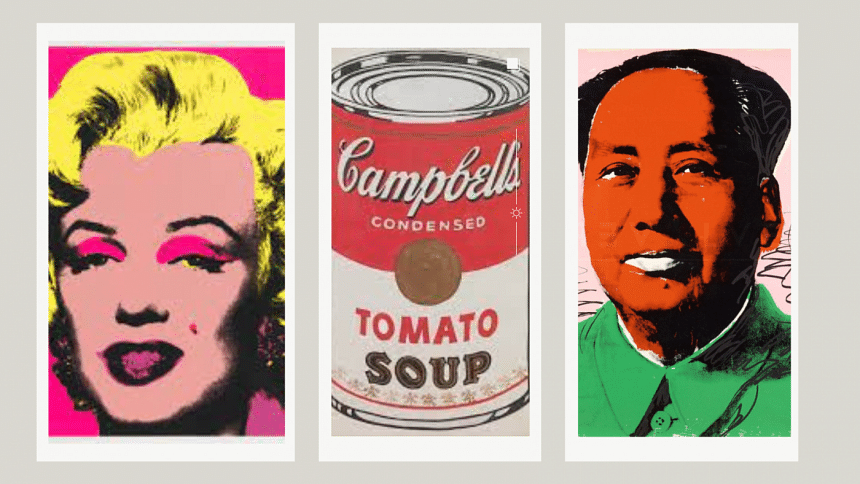5 ways Andy Warhol changed art forever

One of the most well-known and influential artists of the 20th century is Andy Warhol. He revolutionised the idea of artistic expression during the course of his incredibly productive career, emerging as one of the most significant figures in art for succeeding generations. Fashion designers, artists, photographers, singers, and filmmakers have all drawn inspiration from Andy Warhol. He was a prominent American representative of the pop-art movement. His works, 32 Campbell's Soup Cans and Marilyn Diptych, were among the earliest examples of the pop-art movement's emergence in the United States. These works were commercialised and signalled a change in how the world viewed art.
Let's look at how one man's perception of the world led to the creation of an entirely new artistic expression.
The Pop Art movement
Undoubtedly, Andy Warhol is the most influential figure in pop art and is to be credited for its emergence. With a satirical undertone, he used the post-'50s fascination with commercialism, Hollywood, and consumer goods, and transformed everyday figures and objects from American popular culture into some of today's most recognisable pop artworks.
Warhol was able to take an aesthetic stance toward people and things that represented the post-war socio-cultural realities of the time and objectify them to an extreme on his canvases thanks to his own grasp of fame, celebrity culture, and the advent of the media. The art world was permanently impacted by Warhol's edgy, straightforward, and vibrant interpretations of everyday items and Hollywood icons.
The '60s saw Warhol produce some of his most recognisable pieces and launch his first pop art exhibition. Because of his obsession with commonplace American items, Warhol presented them to his audience in novel ways. His paintings of Campbell's soup cans, Coca-Cola bottles, and wooden copies of Brillo soap-pad boxes were displayed in Los Angeles and New York in 1962, gaining him recognition in the art world.
The concept of being 'an artist'
Warhol used a variety of media to communicate his art. He was one of the first to develop "The Factory," a breakthrough idea in the field of art. Everyone used to and still refers to Warhol's studio as "The Factory." The Factory was ground-breaking because it brought creative people together and gave them the chance to work together to create art that still has an impact on society today. By cooperating, people were executing Warhol's instructions. With this technique, he altered what it meant to be an artist by cognitively connecting the finished product to the artist rather than necessarily having a physical connection. In other words, by redefining the artist as "the designer."
The concept of fame
Warhol is credited with coining the expression "15 minutes of fame", which is something we have all heard. He argued that in the future, everyone would have momentary global fame. In a manner, Warhol anticipated the media and celebrity culture of the twenty-first century, where stars come and go quickly and people can become famous just for being who they claim to be or are pretending to be. Warhol recognised that as media became more and more present and significant, people would soon start projecting images of themselves that would occasionally come to represent everything about them in more authentic ways.
His artistic themes
The 1950s Pop Movements repudiated Abstract Expressionism and all of its high art pretensions and celebrated all that had been expelled from Fine Art as a revolt against the established approaches to art, culture, and traditional beliefs on what art should be.
In this regard, Warhol with his key themes of celebrity, identity, money, death and time, had a significant influence on the development of art history as well as American culture, both for the people of the United States and the rest of the world. He promoted the use of art as both a social commentary and a reflection of society, bringing the idea of consumerism to the forefront. He also made silk-screening popular as a creative technique. With this technique, the same image is produced more than once, making it quick and simple to create several coloured variations of the image.
His use of Polaroid cameras and overhead projectors is among his other ground-breaking methods. Warhol favoured bright, frequently gaudy hues. To highlight certain details and make the classic artwork stand out even more, he used high contrast and saturation levels.
Art as a chronological diary
The most significant events of the time can be seen in Warhol's artwork. His "chronicle" of artworks includes works that were influenced by events like the passing of Marilyn Monroe, the last electric chair executions, post-Hiroshima occurrences, and Red China. With his personal lens, Andy Warhol recorded the events that mattered most to people at the time, which had an immense impact on many artists in the future in capturing significant events throughout history.
Warhol was a master of the visual arts and an innovator who experimented with a variety of subjects and media, including canvas painting, photography, video art, and filmmaking. He is perhaps even more legendary because, in addition to using his art to comment on society, he also lived openly as a homosexual during a period of intense heteronormativity. His life was cut short in 1987 at the age of 58 when he experienced cardiac arrest as a result of complications from his gallbladder operation. Yet, his vibrant, instantly recognisable strokes remain timeless in his artwork.

 For all latest news, follow The Daily Star's Google News channel.
For all latest news, follow The Daily Star's Google News channel. 








Comments